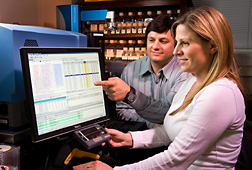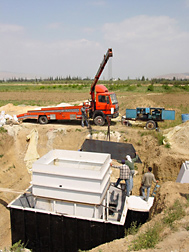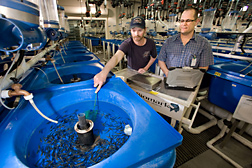ARS and International Partners Team Up
To Solve Common Agricultural Problems
The Agricultural Research Service seeks to assist other countries in finding solutions to agricultural problems that affect us all. The Office of International Research Programs (OIRP) serves as the principal contact for international activities in ARS. Many interactions between ARS scientists and researchers in other countries are formalized through OIRP.
“The mission of OIRP is to enhance the productivity, effectiveness, and impact of the 23 ARS national programs through mutually beneficial international cooperation,” says OIRP acting director Ibrahim Shaqir. “To that end, we strive to participate in activities that promote the strategic interest of the U.S. government and to extend the capacity of ARS national programs to address problems confronting U.S. agriculture.”
Several formal programs are managed, and some have been established. These programs foster the scientific relationships necessary to improve global agricultural practices.
One, the U.S.-Israel Binational Agricultural Research and Development Fund (BARD), begun in 1979, is a competitive funding program jointly conducted by American and Israeli scientists to carry out strategic and applied agricultural research. BARD funds scientists who are affiliated with public or not-for-profit private entities and encourages the exchange of agricultural scientists, engineers, and other agricultural experts.
“Since 1979, BARD has funded more than 900 research projects in locations throughout most of the 50 states,” says Shaqir.
In 1998, the scientific exchange program LABEX was sponsored by EMBRAPA, the agricultural research agency of Brazil. Senior Brazilian researchers can spend up to 3 years at host ARS laboratories, creating productive partnerships between the two institutions in strategically selected research topics, such as integrated pest management, precision agriculture, soil science, and genetic research.
The U.S. Department of State funds the ARS-Former Soviet Union (FSU) Scientific Cooperation Program, which fosters scientific cooperation between ARS scientists and those in research institutes of FSU countries. Since its inception in 1998, $2.85 million in research funds have been provided for projects to study, for example, avian influenza viruses in wild birds and poultry and towards reducing foodborne pathogens like Campylobacter and Salmonella.
|
|
Collaborating To Tame Tenacious Foodborne Pathogens
Cows grazing in picturesque European pastures are—like bovines living elsewhere—susceptible to becoming inadvertent hosts of troublesome microbes. To ensure that those microbes—Campylobacter, Salmonella, toxin-producing Escherichia coli, or Listeria—don’t end up in wholesale and retail cuts of beef, member nations of the European Union and several other countries are pursuing a 5-year research program to identify these organisms; distinguish species, subspecies, and strains from one another; and evaluate the relative virulence of each.
ARS microbiologist William Miller and molecular biologist Craig Parker at the Western Regional Research Center in Albany, California, bring to “ProSafeBeef”—as this international collaboration is known—their expertise in using leading-edge, DNA-based technologies to determine who’s who among these foodborne pathogens. It’s new knowledge that should help public-health professionals locate the source of outbreaks of foodborne illness, and it might also speed development of new tactics to undermine the pathogens. ProSafeBeef is organized and funded by the European Commission.
Meanwhile, the same microbes—and more—are described in some of the 40,000 data sets in ComBase, an international database of pathogens related to food. ARS scientists at the Eastern Regional Research Center in Wyndmoor, Pennsylvania, established ComBase to facilitate risk assessment and model development in collaboration with the United Kingdom’s Food Standards Agency (UKFSA) and the Institute of Food Research (IFR) in Norwich, England.
A user-friendly web browser that the researchers developed in 2003 allows scientists, regulators, and food processors to search ComBase for specific terms and retrieve all relevant data on growth, inactivation, and survival of pathogenic and spoilage microbes in food.
ComBase initially contained data sets drawn from ARS, UKFSA, and IFR. It has since expanded to include data compiled from scientific literature and European research institutions. In 2006, the Australian Food Safety Centre of Excellence joined the team. ComBase also has supporting associates in Greece, Japan, Mexico, and the United Kingdom.
The database (http://wyndmoor.arserrc.gov/combase) receives about 100 hits every day from users around the world.
Fortifying Food Plants—and the World
Plant physiologist Ross Welch is looking for techniques that help plants boost their production of available essential human nutrients.
“This research focuses on one question: Can crops fortify themselves?” says Welch, who works at the Robert W. Holley Center for Agriculture and Health in Ithaca, New York.
In 2003, Welch teamed up with collaborators around the world to use a process called “biofortification” to alleviate malnutrition in developing countries. His partners include other ARS scientists, Cornell University professors, and scientists working with HarvestPlus, a Global Challenge Program of the Consultative Group on International Agricultural Research. This program is funded by the Bill & Melinda Gates Foundation, the U.K. Department for International Development, the World Bank, U.S. Aid for International Development, and other donor organizations.
HarvestPlus is the first global micronutrient intervention program that is based on agricultural practices and innovations.
“Micronutrient malnutrition is responsible for much mortality and sickness and has severely affected worker productivity, particularly for the poor, who can’t afford nutrient-rich foods,” Welch says. “We believe biofortified food crops can be a part of the solution to health issues that affect the developing world.”
Scientists are breeding staple food crops that contain significantly more bioavailable levels of iron, zinc, and provitamin A carotenoids.
To date, Welch and his collaborators have conducted research to improve the absorption, or bioavailability, of iron and zinc in the biofortified target crops. His findings with swine models suggest that breeding for inulin—a plant compound that is metabolized by beneficial bacteria in the colon—may help people absorb more iron from staple food plants. He has also studied iron bioavailability in eight bean genotypes and assessed the distribution of iron, phytate, and phenols in different bean and grain tissues. Phytate and certain polyphenols inhibit iron’s bioavailability.
New DNA Maps for Rainbow Trout
Rainbow trout is one of the most important aquaculture species in the United States and the world, but little is known about its genetic makeup. So ARS and cooperators in France are teaming up to produce detailed maps of trout genes and how they relate to key traits like disease resistance, stress response, and growth.
Geneticist Yniv Palti, at the National Center for Cool and Cold Water Aquaculture in Leetown, West Virginia, has an ongoing collaboration with French National Institute for Agricultural Research scientist Carine Genet to produce an integrated physical and genetic map for rainbow trout.
Recently, the first-generation physical map of rainbow trout was produced in a collaborative effort by Palti with Ming-Cheng Luo and Yuqin Hu of the University of California-Davis. A physical map shows the specific locations of a species’ genes and/or markers on each chromosome. These types of maps are important for finding physical linkage between traits and genes.
“We used variations and similarities among 180,000 trout chromosome fragments to order them on the physical map,” Palti says. “Since it is possible to isolate specific genes from the chromosome fragments, we can now reconstruct the order of the genes on the trout chromosomes and determine whether those specific genes explain certain traits in rainbow trout that influence growth and disease resistance.”
Genet collaborated with Genoscope (French National Sequencing Centre) to sequence important segments of 100,000 of those fragments.
Genet is using the sequence information to design new genetic markers currently being genotyped in Palti’s lab and added to the ARS genetic map. Information from the two maps can be integrated to provide a more complete picture of the trout genome, enabling scientists to pinpoint genes that affect key aquaculture-production traits in rainbow trout.
The ARS genetic map was constructed in a project headed by Leetown scientists Caird Rexroad III and Roger Vallejo.
On Two Continents, Scientists Probe Plants’ Precise Water Needs
As the demand for fresh, clean water for farms and cities continues to accelerate, so does scientists’ search for better ways to determine precisely how much water crop plants actually need. A collaboration between ARS scientist Thomas Trout in Fort Collins, Colorado, NASA researcher Lee Johnson in Mountain View, California, and colleagues in Israel, Jordan, and the Palestinian Authority has provided new evidence that measurements of what’s known as “crop canopy cover” can provide reliable estimates of how much water plants have used and, thus, how much they’ll need at the next regularly scheduled irrigation. Canopy cover is a measure of how much ground a plant covers, or shades.
The researchers evaluated a dozen high-value crops—from almonds to watermelon—growing in 33 different California fields. The work newly demonstrates that crop-canopy measurements, derived from satellite imagery, could help growers conserve water while keeping their plants healthy and properly irrigated.
What’s more, the ARS-Middle East collaboration has led to installation—in Jordan—of a research instrument known as a “weighing lysimeter.” Building on knowledge gained from 59 other lysimeter installations, ARS soil scientist Steve Evett in Bushland, Texas, designed and collaborated in building this lysimeter, the most advanced yet, for Jordan. It was placed in a research vegetable field where, in 2008, sweet corn was the first crop tested.
Evett predicts a great yield of knowledge due to the lysimeter’s ability to very accurately measure how much water the plants use, when that use occurs, and how they respond to weather changes.
“We, in turn, learn from the experience of the Middle Eastern scientists as we see how a new lysimeter design works and how our crop-water-use prediction methods work in a different environment,” Evett says.
“With the information from the lysimeter and a measure of how much ground is covered by each crop’s canopy, combined with local weather data, scientists can tell Jordanian farmers how much water each crop will need,” Evett says. A network of 12 weather stations was installed and is managed by the multination research and extension team so that locally appropriate water use can be estimated.
This information is sent to farmers via text messages on their cell phones and to the team via a website.—By Sharon Durham, Laura McGinnis, Marcia Wood, Ann Perry, and Don Comis, Agricultural Research Service Information Staff.
This research is part of Aquaculture (#106), Food Safety (#108), Human Nutrition (#109), and Water Availability and Watershed Management (#211), four ARS national programs described on the World Wide Web at www.nps.ars.usda.gov.
To reach scientists mentioned in this story, contact Sharon Durham, USDA-ARS Information Staff, 5601 Sunnyside Ave., Beltsville, MD 20705-5129; phone (301) 504-1611, fax (301) 504-1486.
Information for ARS-International Partnership
In April 2008, Environmental Management and Byproduct Utilization Laboratory research leader Matt Smith and microbiologist Walter Mulbry visited Amman, Jordan, to help determine which practices would best manage large quantities of poultry litter. Training programs on composting to increase soil organic matter, increase water retention, and decrease purchased fertilizer use were developed.
During the first visit, Smith and Mulbry went to six farms to conduct on-the-ground fact finding in preparation for the upcoming training programs. The Jarash Valley area of Jordan has a lot of poultry production as well as olive tree groves. The researchers obtained details about poultry production and determined whether other resources, such as olive tree prunings, would be available for use in composting the litter.
In later visits, Mulbry set up compost piles for further study and then conducted workshops “to equip farmers and poultry producers in Jordan with the knowledge and tools necessary to solve their agricultural problems and pass that information on to others,” he says. “It was also important that a minimalist approach to management be found due to limited resources.”—By Sharon Durham, Agricultural Research Service Information Staff.
"ARS and International Partners Team Up To Solve Common Agricultural Problems" was published in the March 2009 issue of Agricultural Research magazine.










